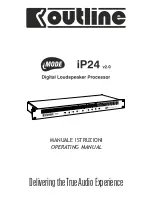
D*AP8
45
Setup GUI –
DOLBY PROCESSING
in general
The Dolby metadata system is quite complex to describe in detail in a product manual such as this.
If you are not familiar with it, we recommend you study the many publications from
Dolby Inc.
Especially the
Dolby Metadata Guide
is essential for understanding the parameters.
For details please visit the Dolby web site:
http://www.dolby.com/gb/en/professional/technology/landing.html
We cannot guarantee that the link is active forever so you may browse other Dolby resources as well.
Specifically concerning metadata we also recommend the SMPTE document RDD6-2008.
So we must assume that you are familiar with this topic.
Metadata emulation means that Dolby metadata will be applied to listen to the effect of it without the need
for encoding / decoding that may become a costly setup and introduces a lot of latency.
The aim is to check the influence of the
Dialnorm
(dialog normalization) value and the
DRC
(dynamic range control) settings.
Important Note!
The
D*AP8
platform is designed to operate an "all Dolby format" decoder and two
independent encoders
A
and
B
. Encoder
B
can be consumer format (D-D, D-D+, AAC)
or
Dolby E
professional while encoder
A
can be a second Dolby E. All solutions are based on the
D*AP8
options
model and require extra hardware and/or licenses.
Setup GUI – DOLBY PROCESSING –
Decoder/Emulation
The Decoder/Emulation functions are built from the Dolby OEM board
CAT1100.
The graphic below illustrates the signal flow through it.
Important Note!
The module
must
be routed into both the audio-
and
the metadata-signal paths.
In order to decode a Dolby stream you
must
feed it to input
DEC1/2
.
The metadata must be routed
by the metadata router:
DOLBY PROCESSING > Metadata > Routing
.
The page embedded graphic shows the building blocks of the CAT1100 module. On the left hand side
you have the decoding blocks, a signal router in the middle, and on the right hand side you have the
downmix and the emulation part. You also can see the actual signal flow and their labels depending on
the input signal status.
The emulation of the influence of metadata can be performed only on one program at a time.
In the above case program 1
"P1"
is pre-selected for emulation. But the signal is actually coming from
the D/D+ decoder because a
D+
signal is present at DEC 1/2 input and will be decoded automatically.
The metadata set of the
D+
stream has a channel mode of
3/2.
Therefore the output labels show a
surround signal
1L/1R
,
1C/1LFE
,
1Ls/1Rs
, while the downmix output label is
Lx/Rx
.
If you feed PCM signals you have the setup mostly used for live or post pro mixing. The
D*AP8
may be
connected to a monitoring insert of the mixing desk. The sound engineer can now switch between his
mix and the emulated version of his surround mix or the downmix of it. He may now change DRC and
downmix metadata by the generator to see how it would sound at home.
















































